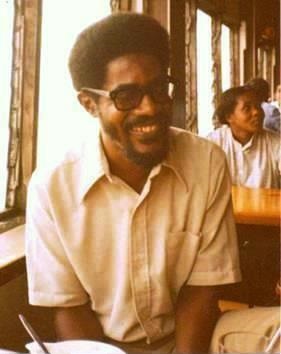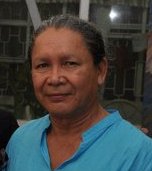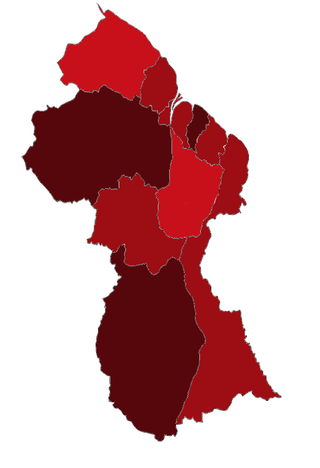
Georgetown is the capital and largest city of Guyana. It is situated in Demerara-Mahaica, region 4, on the Atlantic Ocean coast, at the mouth of the Demerara River. It is nicknamed the "Garden City of the Caribbean." It is the retail, administrative, and financial services centre of the country, and the city accounts for a large portion of Guyana's GDP. The city recorded a population of 118,363 in the 2012 census.
Guyanese culture reflects the influence of African, Indian, Amerindian, British, Portuguese, Chinese, Creole, and Dutch cultures. Guyana is part of the mainland Caribbean region. Guyanese culture shares a continuum with the cultures of islands in the West Indies.

Walter Anthony Rodney was a Guyanese historian, political activist and academic. His notable works include How Europe Underdeveloped Africa, first published in 1972. Rodney was assassinated in Georgetown, Guyana, in 1980.

Linden Forbes Sampson Burnham was a Guyanese politician and the leader of the Co-operative Republic of Guyana from 1964 until his death in 1985. He served as Premier of British Guiana from 1964 to 1966, Prime Minister of Guyana from 1964 to 1980 and then as the first Executive President of Guyana from 1980 to 1985. He is often regarded as a strongman who embraced his own version of socialism.
Guyanese literature covers works including novels, poetry, plays and others written by people born or strongly-affiliated with Guyana. Formerly British Guiana, British language and style has an enduring impact on the writings from Guyana, which are done in English language and utilizing Guyanese Creole. Emigration has contributed to a large body of work relating the Guyanese diaspora experience.
Eusi Kwayana, formerly Sydney King, is a Guyanese politician. A cabinet minister in the People's Progressive Party (PPP) government of 1953, he was detained by the British Army in 1954. Later he left the PPP to form ASCRIA, a Pan-Africanist grassroots political group that, after a brief flirtation with the People's National Congress (PNC) of Forbes Burnham, fused into the Working People's Alliance (WPA). Kwayana is also a playwright.
Aishalton is an Amerindian village that is situated in the Rupununi savannah of southern Guyana, in the Upper Takutu-Upper Essequibo Region of the country.

The National Cultural Centre, the premier auditorium for cultural presentations in Georgetown, Guyana. It is on Homestretch Avenue, in D’Urban Park. It hosts theatre, music, and dance as well as other events.
Ruel Johnson is a Guyanese author.
Religion is an important aspect of identity and society in Guyana. In 2012 the population was 63% Christian, 25% Hindu, 7% Muslim. Religions are reflected by East Indian, African, Chinese, and European ancestry, as well as a significant indigenous population. Members of all ethnic groups are well represented in all religious groups, with two exceptions: most Hindus are Indo-Guyanese, and nearly all Rastafarians are Afro-Guyanese people. Foreign missionaries from many religious groups are present. Christianity has historically been associated with Afro-Guyanese.
Andrew Morrison, SJ was a Guyanese Roman Catholic Jesuit priest, journalist, and pro-democracy activist.
Sophia is a ward of Georgetown, the capital of Guyana. It's a predominantly Afro-Guyanese community, and one of Georgetown's poorest neighborhoods.

George Simon was a Guyanese Lokono Arawak artist and archaeologist. He was the founder and mentor of the Lokono Artists Group, a group of Lokono artists from Guyana, based primarily in his hometown of St. Cuthbert's Mission. Simon was widely regarded as one of the leading Guyanese artists of his generation, and his paintings are notable for their explorations of Amerindian culture and the Guyanese environment. He was also recognized for his achievements as an educator, his efforts to develop opportunities for Amerindian artists in Guyana, and for his work as an archaeologist.

The COVID-19 pandemic in Guyana was a part of the worldwide pandemic of coronavirus disease 2019 caused by severe acute respiratory syndrome coronavirus 2. The virus was confirmed to have reached Guyana on 11 March 2020. The first case was a woman who travelled from New York, a 52-year-old woman with underlying health conditions, including diabetes and hypertension. The woman died at the Georgetown Public Hospital.
Arnold Gibbons is a Guyanese cricketer and professor of communications. He played in two first-class matches for British Guiana in 1952/53 and 1953/54.
Clive Youlande Thomas is a Guyanese economics professor and political activist. He publishes on issues relating to development and poverty eradication in Guyana and the greater Caribbean region.

Joseph Linden Fitzclarence Hamilton is a Guyanese politician. Hamilton was born Triumph, British Guiana. Between 1977 and 1987, Hamilton was a priest of the House of Israel. At the 2014 Walter Rodney inquiry, Hamilton testified that the House of Israel committed “oppressive and terrorizing acts on behalf of the People's National Congress (PNC).”
Tchaiko Ruramai Kwayana, born Ann Cook, was an educator, pan-Africanist, and civil rights activist from Georgia, US. She was married to Eusi Kwayana, Guyanese politician.
St. Ignatius is an Amerindian village in the Upper Takutu-Upper Essequibo region of Guyana, near the regional capital Lethem and the border of Brazil. It was originally a mission founded by Jesuit priests to serve the Amerindians in the Rupununi savannah.








